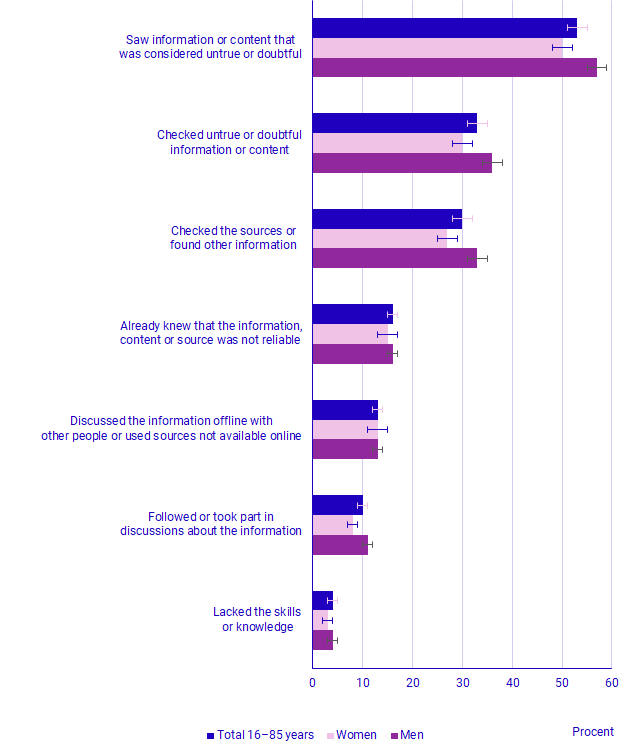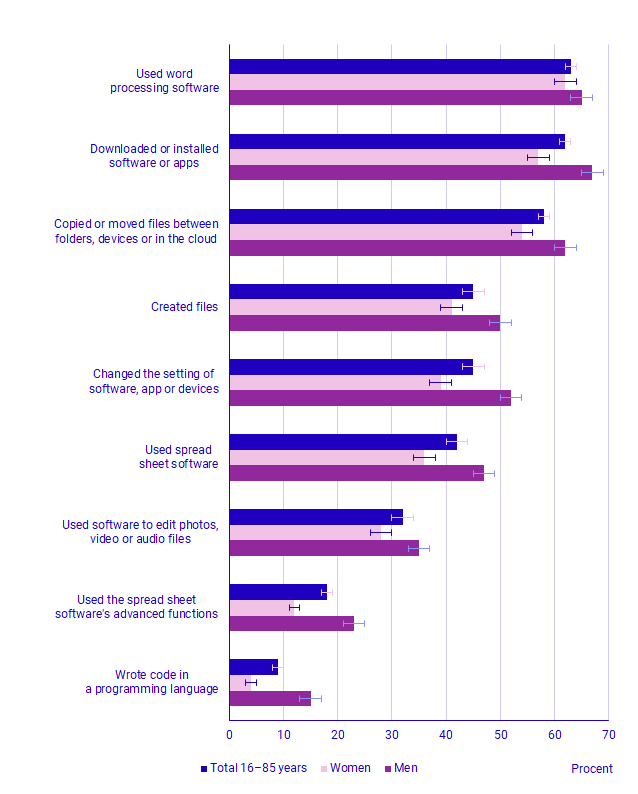ICT usage in households and by individuals 2021
One in three people check the truthfulness of false information online
Statistical news from Statistics Sweden 2021-11-18 9.30
In Sweden, 89 percent of the population aged 16–85 years, corresponding to 7.3 million people, use the internet essentially every day. This year’s survey on ICT usage in households and by individuals shows that one in two people who use the internet have seen untrue or doubtful information on the internet and one in three people have checked the truthfulness of the information.
It is important to be able to critically examine a source to form an opinion concerning its reliability, purpose and origin. In total, 53 percent of Sweden’s population aged 16–85 years state that they have seen untrue or doubtful information on the internet. They were then asked whether they checked the truthfulness of the information and how they checked it, the results of which are shown in the figure below. Men are more likely than women to check untrue or doubtful information on the internet. This proportion was 36 percent for men and 30 percent for women. Men and women to the same extent discuss the information with others or use sources not on the internet.

One in ten people expressed personal opinions on the internet
A number of various areas of use for the internet were surveyed; the most common use was sending and receiving e-mail. Among the population, 87 percent stated that they have used e-mail in the past three months. Other common areas of use included using internet banking, finding information about goods or services, reading online news, which around 8 in 10 had done. Other common uses of the internet included making calls or video calls and using instant messaging, which 7 in 10 did. Women used the internet to a greater extent than men for instant messaging, participating in social networking sites, or seeking health-related information.
One in four people looked for a job, sold goods or services or did an online course. Twelve percent have expressed personal opinions about political or civic issues, and 7 percent took part in official discussions to influence civic or political issues. There are no significant differences between the sexes in these categories.
| Area of use | Total 16–85 years | Men | Women |
|---|---|---|---|
| Sent/Received e-mails | 87 | 86 | 87 |
| Carried out banking matters online | 81 | 81 | 81 |
| Sought information about goods/services | 80 | 81 | 78 |
| Read news online | 77 | 78 | 76 |
| Telephone or video calls | 72 | 70 | 74 |
| Instant messaged | 71 | 67 | 75 |
| Participated in social media online | 67 | 62 | 73 |
| Sought health-related information | 65 | 60 | 70 |
| Looked for work or submitted a job application | 25 | 23 | 27 |
| Sold goods or services | 25 | 24 | 27 |
| Took an online course | 25 | 24 | 26 |
| Expressed opinions on political or social issues | 12 | 12 | 12 |
| Took part in official consultations to influence civic or political issues | 7 | 6 | 7 |
More men than women programming
As digitalisation increases, programming skills are becoming more important. The results of this year’s survey for men and women aged 16–85 years show that 15 percent of the men had written code in some programming language, compared with 4 percent of the women. In terms of skills such as creating files, changing settings of software, apps or devices, using spreadsheet software or writing code in a programming language, there were stark differences between the sexes. The differences were smaller with regard to using word processing software, which 63 percent of the population had done. Furthermore, 67 percent of the men and 57 percent of the women had downloaded or installed software or apps.

Other results from the survey ICT usage in households and by individuals 2021
All results refer to Sweden’s population aged 16–85 years. The collection period for this survey was from April to June 2021. The reference period is defined as the last three months before the survey response, unless otherwise specified.
- Nine in ten people have access to the internet at home. The most common type of internet connection at home was a fixed broadband connection, which 83 percent of the population used in the past three months.
- In total, 3 percent of the population had never used the internet. People who had never used the internet were largely found in the age group 75–85 years. This group stands out, as 21 percent have never used the internet.
- Among the population, 74 percent made online purchases in the last three months. Eight in ten people who live in cities and seven in ten people in towns and suburbs have purchased or ordered something online during the period.
- Among many goods included in the survey, clothes, medicine and cosmetics were the most common types of goods purchased online. One in two people purchased clothes, one in three people purchased medicine and one in four people purchased cosmetics. Among services, one in four people purchased music or films and series online; there are no significant differences between the sexes in these two categories.
- The most common reason for not buying anything online is because people preferred to shop in person and liked to see the product. Among people who never shopped online, 10 percent stated this reason.
- Fifty-nine percent restricted or refused access to their geographical location, while 39 percent restricted or refused access to their profile, content on social networking sites or shared online storage.
- In total, 74 percent of the population know that cookies can be used to trace people’s activities online and create a profile for each user and thereby tailor advertising. Four in ten people answered that they were not concerned about this, while one in ten was very concerned.
Definitions and explanations
These statistics are based on the survey ICT usage in households and by individuals that forms part of Sweden’s official statistics. The survey includes around 150 questions on access to and usage of information technology. All the statistics presented here, and much more, can be retrieved from the Statistical Database on Statistics Sweden’s website. The publication of the 2021 results includes three new study domains: disposable income in quintiles, level of urbanisation, and industry. The new study domains will be published in the Statistical Database for 2021 and will include all variables.
The results from this survey are also being presented in a report on e-commerce published on 18 November 2021.
For matters concerning how these statistics were produced and a description of the quality, please see the documentation “Statistikens framställning” (2021) and “Kvalitetsdeklaration” (2021) available (in Swedish) on Statistics Sweden’s website. For help with explanations of the results, producing documents or similar, feel free to contact us.
ICT usage in households and by individuals
Statistics Sweden has included the age group 74–85 years in the sample as from 2014. For historical comparisons, we recommend using the total. The EU cooperation and the statistics published on Eurostat’s website use the age group 16–74 years.
Statistical Database
More information is available in the Statistical Database
Feel free to use the facts from this statistical news but remember to state Source: Statistics Sweden.
